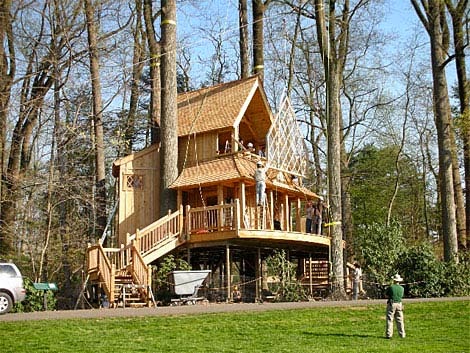It's not easy to build a substantive house around a
tree (or trees). If you do your job right, the trees will continue to
grow, but you won't have to re-build your treehouse every year. Some of
the world's best treehouse designers opened up to PM about how they do
their jobs—and shared pictures of their favorite designs.
1. The Lodge Treehouse
Not all treehouses are deep in the forest. All it takes is one
good, sturdy trunk: This Scots Pine fits the bill. Derek Saunderson and
his team at Amazon Treehouses
fashioned the Lodge after an existing home on a plot in the Scottish
Highlands, using a two-tiered support system of planks that hug the tree
at both its midsection and near to the ground.
There's not a thing about this loch-side dwelling that isn't scenic. It's got plenty of water-facing windows that offer views and natural light. Its staircase, not to be outdone by the rest of the construction, runs between two large boughs of the pine as it leads up to the Lodge.
Treehouses such as this aren't cheap--an elaborate one like the Lodge can cost in the ballpark of $100,000.
There's not a thing about this loch-side dwelling that isn't scenic. It's got plenty of water-facing windows that offer views and natural light. Its staircase, not to be outdone by the rest of the construction, runs between two large boughs of the pine as it leads up to the Lodge.
Treehouses such as this aren't cheap--an elaborate one like the Lodge can cost in the ballpark of $100,000.
2. David Wenzel Treehouse
Bill Allen of Forever Young Treehouses
has made a name for himself building handicap-accessible treehouses,
and this tree-topper in Nay Aug Park in Scranton, Pennsylvania is no
exception. He's built houses for camps and parks, and the Nay Aug Park
structure is the highest house he's built--it's 35 ft off the ground,
right at the edge of a waterfall that drops 125 ft.
Allen's treehouses tend to be pretty simple at first glance. They rarely include amenities, unless a camp expects kids to sleep in the treehouse overnight, in which case he'll toss in some power and a bathroom. To him, a treehouse itself is special enough: "I feel like there's plenty of electricity in the world," he told PM, "but there aren't many treehouses 35 ft off of the ground."
Rather than use an elevator, the Nay Aug Park structure instead has a gently sloped, winding ramp leading up to it. This keeps the flow of traffic moving and offers an undeniably nice view.
Allen's treehouses tend to be pretty simple at first glance. They rarely include amenities, unless a camp expects kids to sleep in the treehouse overnight, in which case he'll toss in some power and a bathroom. To him, a treehouse itself is special enough: "I feel like there's plenty of electricity in the world," he told PM, "but there aren't many treehouses 35 ft off of the ground."
Rather than use an elevator, the Nay Aug Park structure instead has a gently sloped, winding ramp leading up to it. This keeps the flow of traffic moving and offers an undeniably nice view.
3. Longwood Gardens
Another treehouse by Jake Jacob and his TreeHouse Workshop,
the Longwood Gardens abode in Pennsylvania looks more like a cathedral
than anything else. It's supported by both trees and house-to-ground
pillars, but the real challenge was installing a specially cut $38,000
window.
To get the job done, Jacob employed a block-and-tackle technique called "treehouse rigging" that his team has helped pioneer. Basically, a sturdy tree is almost as good as having a crane on-site: "We use the trees that we're working in as pick-points for serious rigging," Jacob said. "Trees can help move a lot of stuff up, but also horizontally." Luckily there was a path running right up to the house, so Jacob and his team could transport the 12-sq-ft glass to the Longwood Gardens doorstep and install it.
The Longwood Gardens treehouse accompanies three other treehouses already on the premises and acts as a rustic lookout point from which to enjoy the gardens.
To get the job done, Jacob employed a block-and-tackle technique called "treehouse rigging" that his team has helped pioneer. Basically, a sturdy tree is almost as good as having a crane on-site: "We use the trees that we're working in as pick-points for serious rigging," Jacob said. "Trees can help move a lot of stuff up, but also horizontally." Luckily there was a path running right up to the house, so Jacob and his team could transport the 12-sq-ft glass to the Longwood Gardens doorstep and install it.
The Longwood Gardens treehouse accompanies three other treehouses already on the premises and acts as a rustic lookout point from which to enjoy the gardens.





















0 commentaires :